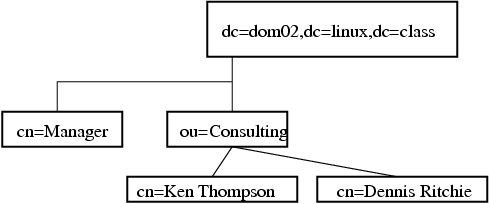| |
Practical exercises:
LDAP commands.
On the server, master, create a new directory, LDAP_dev, where you will have ldif files.
Compose a new LDIF file, init.ldif, with the content shown below:
# Root node
dn: dc=dom02,dc=linux,dc=class
objectclass: organization
objectclass: dcObject
o: dom02.linux.com
dc: dom02
# The list branch node
dn: ou=Consulting, dc=dom02,dc=linux,dc=class
objectclass: organizationalUnit
ou: Consulting
# The Super-User's node
dn: cn=Manager, dc=dom02, dc=linux, dc=class
objectclass: organizationalRole
cn: Manager
# A leaf node
dn: cn=Dennis Ritchie, ou=Consulting, dc=dom02,dc=linux,dc=class
objectclass: person
cn: Dennis Ritchie
sn: Ritchie
# Another leaf node
dn: cn=Ken Thompson , ou=Consulting, dc=dom02,dc=linux,dc=class
objectclass: person
cn: Ken Thompson
sn: Thompson
|
The content of the LDIF file, init.ldif, represents the following directory tree:

Populate the content of init.ldif into the LDAP by executing
command ldapadd with binding as the LDAP manager:
On the client, n01, run ldapsearch commands:
On the server, master, create a new LDIF file, people.ldif:
dn: ou=passwords, dc=dom02, dc=linux, dc=class
ou: passwords
objectclass: organizationalUnit
dn: ou=group, dc=dom02, dc=linux, dc=class
ou: group
objectclass: organizationalUnit
|
Add it to the LDAP database by using command ldapadd:
Check if the "ou" entries are in the database by running
Delete Organizational Units "passwords" and "group":
create a file, delp.txt:
ou=passwords, dc=dom02, dc=linux, dc=class
ou=group, dc=dom02, dc=linux, dc=class
|
Run
Modify people.ldif:
dn: ou=People, dc=dom02, dc=linux, dc=class
ou: People
objectclass: organizationalUnit
dn: ou=group, dc=dom02, dc=linux, dc=class
ou: group
objectclass: organizationalUnit
|
Run
Now the LDAP directory looks as follows:

|
|

